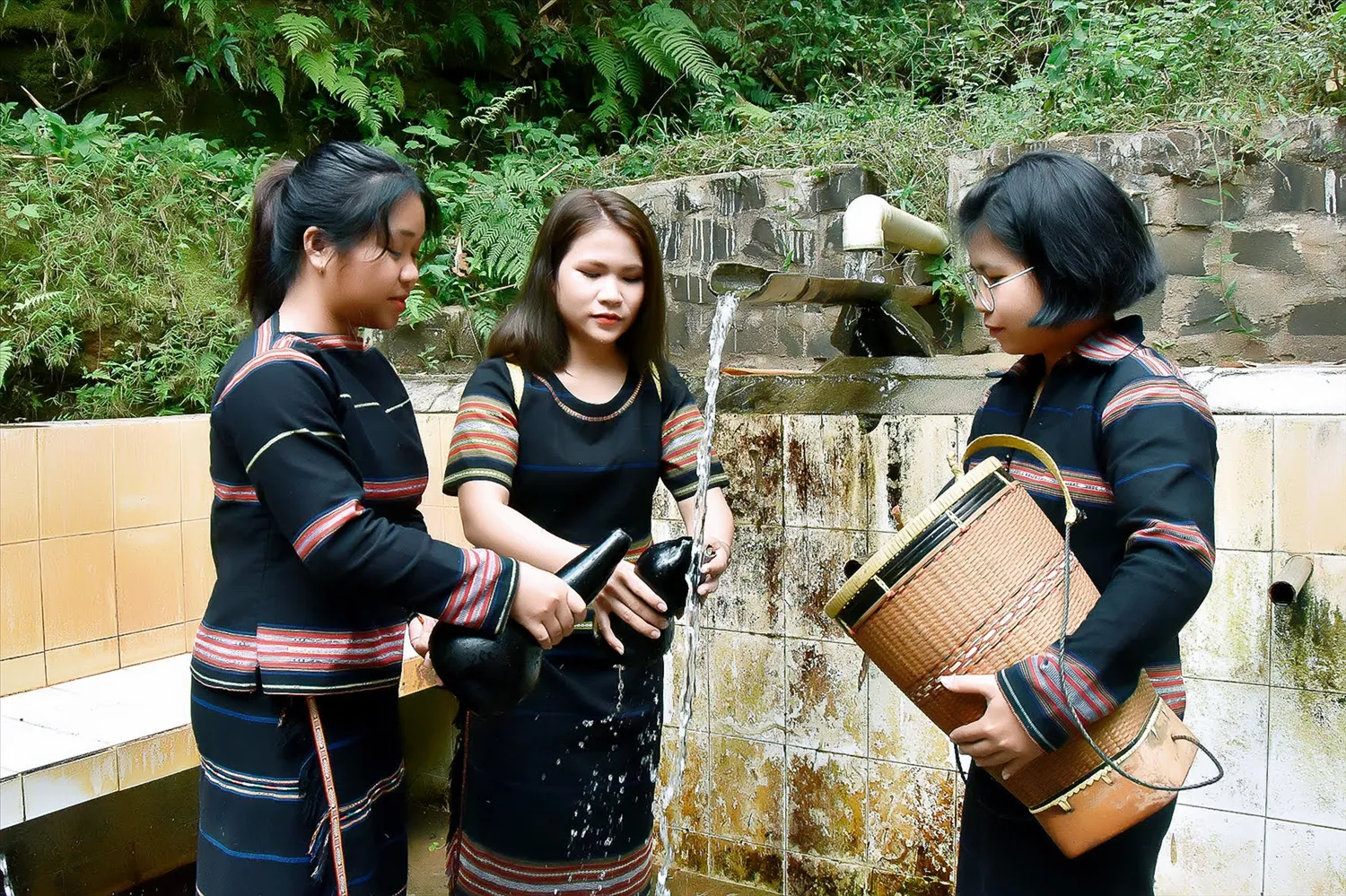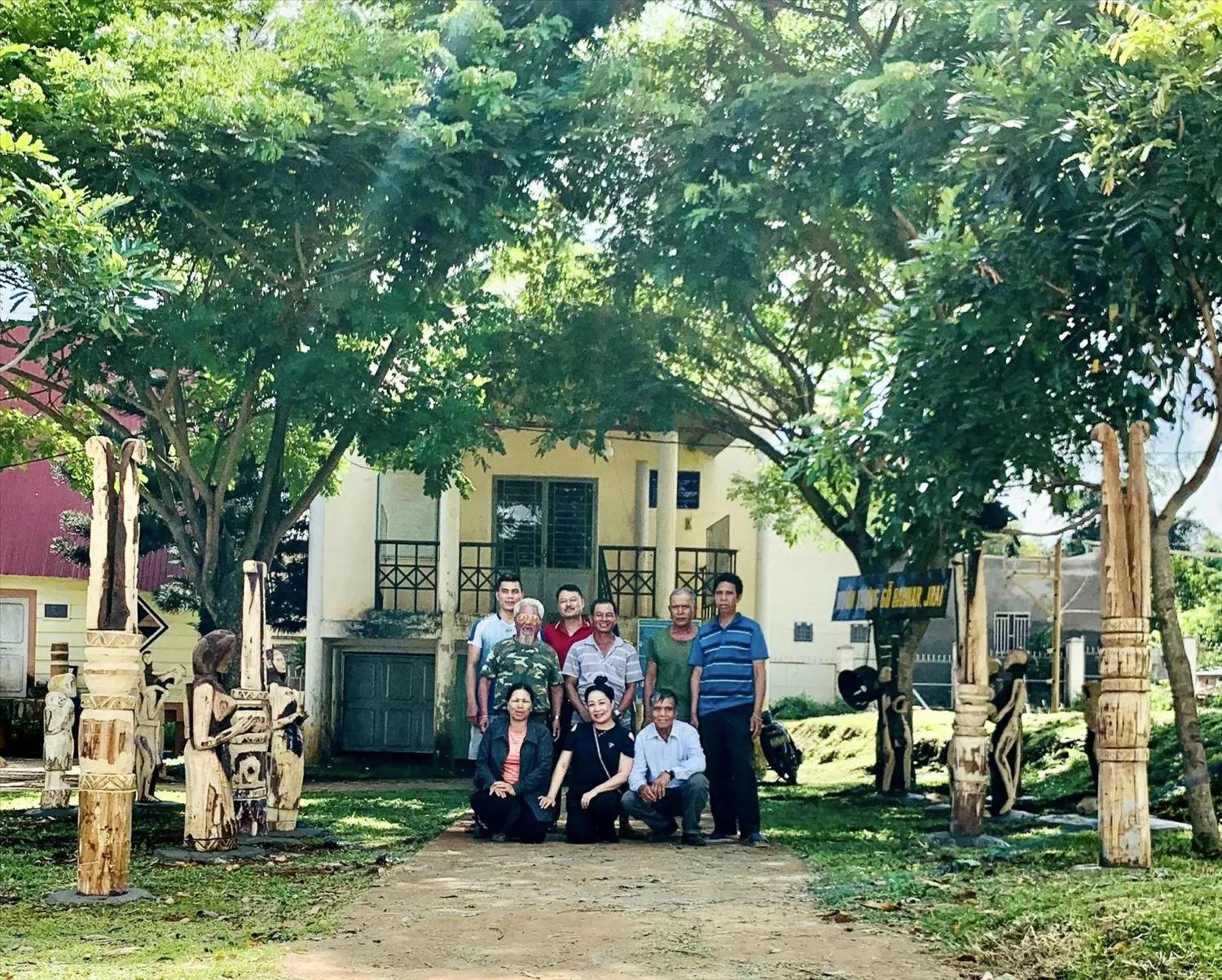Pleiku, the dreamy mountain city, captivates visitors not only with the majestic natural beauty of Bien Ho Lake or the lush green tea hills, but also with its unique and rich ethnic culture. In the heart of this modern city, Bana villages still quietly exist, preserving precious traditional values. Bana village community tourism is gradually opening its doors, inviting visitors to discover a very different Gia Lai, an original and captivating Vietnam.
This article will guide you to typical Bana villages in Pleiku, where tourism is not just an experience, but also a deep cultural connection, a journey to discover identity and share life. Let “Du lịch khắp thế gian” (Travel Around The World) lead you into the world of soaring Rong houses, resonating gong sounds, and the hospitable, friendly Bana people.
Op Village and Ia Nueng: Typical Community Tourism Destinations
Nestled in the Ia Lầm valley and embraced by the Ia Nin and Ia Năk streams, Op village (Hoa Lu ward, Pleiku city) appears like a peaceful green oasis. Established in 1927, Op village is home to the Gia Rai community, a branch of the Bana ethnic group. To this day, despite many changes over time and urban development, Op village still retains its pristine beauty and unique traditional cultural features.
Similar to Op village, Ia Nueng village (Bien Ho commune, Pleiku city) is also a highlight in community tourism in Gia Lai. Located near the poetic Bien Ho Lake, Ia Nueng captivates visitors with its brilliant purple-yellow flower paths, ancient star apple gardens providing shade, and especially the clear spring at the end of the village, the life source of the entire community. Both villages are vivid evidence of the resilient vitality of Bana culture in the heart of the city.
.jpg)
Discovering Bana Culture: From Rong Houses to Gongs
Bana village community tourism is not just sightseeing, but also an opportunity for visitors to immerse themselves in the local life and culture. Coming to Op or Ia Nueng village, you will admire the soaring Rong houses, architectural and cultural symbols of the Bana people. The Rong house is not only a place for community activities and festivals but also a sacred space, preserving the spiritual values and history of the village.
Gong music is an indispensable part of the cultural life of the Bana people. The majestic sounds, echoing through the mountains and forests, are not only art but also the voice of the soul, connecting people with nature and ancestors. Visitors can enjoy unique gong performances, listen to stories about the history and meaning of this unique art form.
Traditional festivals are also an attractive cultural highlight. The Po Thi (tomb leaving) festival, the new rice celebration… are occasions for the Bana community to express gratitude to the gods, pray for bountiful harvests, and strengthen community bonds. Participating in festivals, visitors will experience the vibrant atmosphere, brilliant colors, and gain a deeper understanding of the beliefs and customs of the Bana people.
Folk wooden statue carving is also a unique feature in Bana culture. Wooden statues with various shapes and expressions are placed solemnly in the Rong house or community activity house, reflecting the worldview, humanistic view, and talent of Bana artisans. In Ia Nueng village, the “Ba Na, Gia Rai Wooden Sculpture Garden” displayed at the community activity house is a must-visit destination for those who love art and want to learn about folk culture.
In addition, visitors can also learn about the traditional brocade weaving craft, admire exquisite handicrafts imbued with Bana cultural identity. Brocade products are not only everyday items but also meaningful gifts, showing the skillful hands and soul of Bana women.

Unique Community Tourism Experiences in Bana Villages
Bana village community tourism offers unique and memorable experiences, completely different from mass tourism.
Immerse yourself in local life: Visitors can choose homestay accommodation, sleeping in traditional stilt houses, eating and living with Bana people. This is a great opportunity to learn about the customs, habits, lifestyle, and family culture of the Bana people. The hospitality and friendliness of the locals will surely make you feel warm and welcome.
Explore nature: Op and Ia Nueng villages are blessed with beautiful natural landscapes. Visitors can leisurely stroll along clean village roads, admire the green rice fields, fruitful vegetable gardens, or immerse themselves in cool streams. The peaceful and poetic scenery of the Bana countryside will help you relieve all the stress and fatigue of urban life.
Participate in cultural activities: Visitors can participate in traditional cultural activities such as learning to play gongs, Xoang dance, brocade weaving, wooden statue carving (depending on the village’s ability and arrangements). These are practical experiences that help visitors understand Bana culture more deeply and contribute to preserving precious traditional values.
Enjoy local cuisine: Bana cuisine is also an unmissable part of the cultural discovery journey. Visitors can enjoy local specialties made from fresh local ingredients such as grilled chicken with bamboo-tube rice, Canh La Bep soup, Ruou Ghe (rice wine)… This is an opportunity for you to experience the unique flavors of the Central Highlands mountains and forests and discover the diversity of Vietnamese cuisine.
Cultural exchange: Community tourism is an opportunity for visitors to interact and chat with local people, listen to stories about their history, culture, and life. The openness and sincerity of the Bana people will give you beautiful memories and meaningful lessons about life.

Developing Sustainable Community Tourism in Bana Villages
Developing community tourism in Bana villages not only brings economic benefits to local people but also contributes to preserving and promoting traditional cultural values. Local authorities and communities are striving to build sustainable community tourism projects, focusing on environmental protection, respect for culture, and creating high-quality tourism experiences.
The establishment of community tourism management boards, training local human resources knowledgeable about culture and tourism, investing in infrastructure, and upgrading tourism products are important steps to develop Bana village community tourism professionally and sustainably.
Bana village community tourism is not just a trend but also a right direction, bringing benefits to both tourists and local communities. Tourists have the opportunity to experience unique culture, explore beautiful nature, and contribute to the sustainable development of the community. Local people have more income, are motivated to preserve culture, and are proud of their ethnic identity.
Conclusion
Bana village community tourism in Gia Lai is a meaningful cultural discovery journey and a unique experience. Coming to Op, Ia Nueng, or other Bana villages, you will not only admire the natural beauty but also immerse yourself in a unique cultural space, meet hospitable and friendly people. Take a trip to the Bana villages in the heart of Pleiku city to feel the difference, to discover traditional cultural values, and to experience community tourism in the most complete way. Bana village community tourism promises to be an attractive destination on the Vietnam tourism map, bringing profound cultural experiences and contributing to the sustainable development of Gia Lai province.